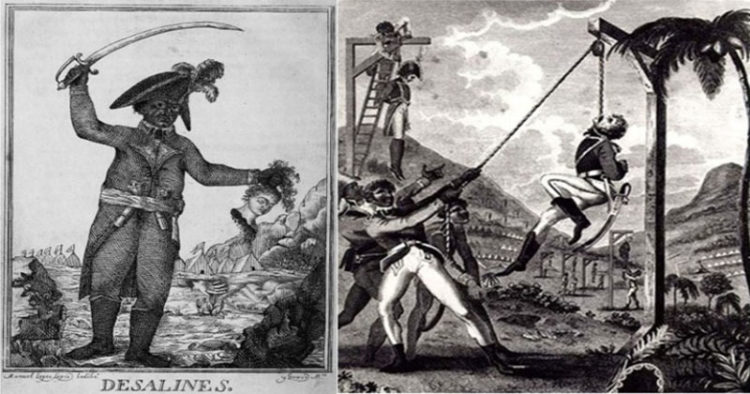The True Story of Haiti — and the Mass Murder of Whites Under Black Rule
THE CARIBBEAN STATE OF HAITI serves as a striking reminder of just how deadly the practice of slavery could be. By 1804, the combined effect of thirteen years of uprisings, murder, and terrorism had destroyed the White population of Haiti, along with all agricultural production and the economy of what was formerly the most prosperous colony in the Western Hemisphere.
The island, originally named San Domingo, had become a center of Spanish activity during the time of the conquistador Hernando Cortes. The Spanish retained a small presence on the eastern side of the island, which is today known as the Dominican Republic. The western part of the island was settled by French traders in 1697 and renamed Saint-Domingue, and it was here that the ferocious race war took place.
The local Amerinds, called Canibales by the Spanish on account of their cannibalistic habits, had been reduced to insignificance by a combination of Spanish force of arms, slavery, and European diseases to which they had no immunity. As a result, the French started importing African slaves to work in the colony.
“The Jewel in the Crown” — Supplies Half of Europe’s Sugar Needs
By 1789, San Domingue was the jewel in the French colonial crown. Its ideal climate and naturally rich soil produced more sugar, coffee, and cotton than all of the then existing colonies in North America put together. San Domingue’s sugar output supplied not only all of France’s requirements, but half of the European continent’s needs as well.
San Domingue’s wealth was legendary, and by the time of the French Revolution, some 40,000 Whites had settled in the colony. However, by this stage there were at least 450,000 Black slaves toiling in the fields to maintain the island’s prodigious agricultural output, and in addition there were approximately 27,000 mulattoes. This huge non-White population, mostly kept under conditions of slavery, provided the demographic time bomb which utterly destroyed the White colony.
French Revolution — Move to Give Non-Whites the Franchise
The French Revolution of 1789 served as a spark which ignited the long-simmering racial pressures in San Domingue. A decree by the French national assembly of May 15, 1791, gave the White and mixed-race population on the island the right to vote.
The White settlers on the island immediately protested. The aptly-named governor general of the island, Blanchelande, sent a message to Paris warning that the implementation of such a form of government would result in “a frightful civil war” and the loss of the colony for France.
The French National Assembly then rescinded the earlier decree and issued a new one saying that the colonists themselves could decide on what form of government was best for their own particular circumstances. When this news was made known in San Domingue, it heightened tensions. The mixed-race population in particular were in an uproar after being informed that they had the vote and then only a few months later told the opposite.
“Amis des Noirs” — French Revolutionaries
A strong anti-slavery lobby, Amis des Noirs (“friends of the Blacks”), developed in France, and grew increasingly powerful over the course of the revolution. This abolitionist group agitated constantly for emancipation and full political rights for both mulattoes and Blacks in San Domingue, and reacted with outrage to the second decree which took away the right to vote for the mixed-race element.
As a result of the Amis des Noir’s efforts, the French national assembly issued a third decree which gave voting rights back to mulattoes and “free blacks,” that is, those Blacks not under any form of indentured labor.
When this news was received in San Domingue, the now-armed Black population launched a violent rebellion. Whites were attacked at random, plantations burned, and the island plunged into chaos. The mixed-race population initially sided with the Whites but then switched allegiance to the Blacks.
Blacks Exterminate All Whites in Haiti
By the end of the uprising in Haiti, every White man, woman, and child had been murdered. Once the Whites had been exterminated, the Black population then turned on the mixed-race population and wiped them out as well.
Chaos Reigns for Ten Years
The chaos continued until 1802 when a detachment of twenty thousand French troops was sent by Napoleon Bonaparte to restore order to the island. The French forces, under the command of Napoleon’s brother-in-law, General Leclerc, crushed the rebellion. The insurgents were ruthlessly hunted down and the main rebel leaders forced to pledge allegiance to the new French government.
Just when the situation seemed to have stabilized, two disastrous events occurred. The first was the news that the Napoleonic government had given permission for the reinstitution of slavery, and the second was an outbreak of yellow fever on San Domingue. The possibility that the institution of slavery could return reignited Black unrest on the island. Meanwhile, the already thinly stretched French forces were decimated by disease, which killed as many as 160 soldiers per day. By August 1802, four fifths of the French troops who had arrived earlier in the year were dead.
Napoleon sent ten thousand fresh troops to bolster the beleaguered French garrison. The new troops were also laid low by yellow fever, and the rebellious Blacks, largely immune to the disease, stepped up their attacks. The security situation on the island deteriorated once again.
The conflict then took an even nastier turn. The French authorities decided that the only way to bring the twelve-year-old race war to an end was to kill all Black inhabitants over the age of twelve years. The reasoning for this was that any adult Black who had, for the previous decade at least, waged a racial war against Whites, would never meekly go back to working in the fields. The same applied to Black women, the French decided, as the females of that race had proven themselves to be even more vicious and cruel to captured Whites than their menfolk. With ruthless energy, the surviving French troops pursued their new orders, and many Blacks were killed in this arbitrary fashion. Both sides were plunged into a spiral of tit-for-tat atrocities which seemed to have no end.
French Withdraw and Blacks Rule
The outbreak of the Napoleonic Wars intervened in developments on the island. France became embroiled in a war with Britain at sea, and the French colonial possession of San Domingue came under attack. The British navy blockaded the island, cut off supplies to the French garrison, and supplied the Black rebels with guns and ammunition.
The most prominent of the Black rebel leaders, Dessalines, launched a number of attacks on the increasingly isolated French garrisons in the coastal towns. Dessalines took town after town from the weakened French forces, and systematically exterminated all the Whites taken prisoner. By November 10, 1803, the French could no longer hold out and surrendered to the British fleet off the coast. Of the fifty thousand French troops sent to the island, only a few thousand ever made it back to France.
The Massacre of the Last Whites
With the French gone, the Black leader Dessalines had a free hand in instituting his own reign of terror against any Whites still unfortunate enough to be on the island state. San Domingue was renamed Haiti in December 1803 and declared independent.
The country became the second independent nation in the Western Hemisphere (after the United States of America) and the first independent Black-ruled nation in the Caribbean.
Having disposed of the Whites, the Blacks and the mixed-race population turned on each other in yet another race war. This ended with the almost complete annihilation of the mulatto population, and in October 1804, Dessalines declared his people to be the winners. To mark the occasion, he declared himself “emperor for life” of Haiti.
The same year, Dessalines asked those Whites who had fled, to return and help rebuild the economy. A surprisingly large number of colonists took up his offer, but soon discovered the nature of their error.
Early in 1805 the Black population once again rose up against the returned White settlers. Dessalines was powerless to control the mobs, despite the White colonists’ pleas. The Europeans were hunted down and, on March 18, 1805, the very last White person in Haiti was killed.
San Domingue, which under French rule was once the richest land in all the Caribbean, is today a Third World shambles of poverty, anarchy, and chaos. This state of affairs is even more meaningful when it is considered that the independent state of Haiti is only thirty-five years younger than the United States of America.
It is a devastating counterargument to the “environmental” theory of development — because if time and environment were the only factors influencing civilization, Haiti, in theory, should be as advanced as America.
* * *
Source: Daily Archives







first negroes freemasonry (inspired by jews )in history..
The Haitian flag is similar to the French flag but with all the white removed.
Black Rule: Lincoln’s Black Republicans unleashed ultra modern Negro armies (175 USCT) on the North American continent for the exclusive purpose of killing White people. From the 1860s forward, the Federals have spread their magnificent colored troops across the world.
What goes around comes around. Both Mr. Lincoln and Mr. Obama claim Illinois as their home state.
23 Negroes received the Medal of honor in the 4 years war. No medal department in the Southern Confederacy. The highest honor was to be mentioned in a battle report or dispatch.
Article: “When this news was received in San Domingue, the now-armed Black population launched a violent rebellion. Whites were attacked at random, plantations burned, and the island plunged into chaos.” Around blax, never relax. Article: “Meanwhile, the already thinly stretched French forces were decimated by disease, which killed as many as 160 soldiers per day. By August 1802, four fifths of the French troops who had arrived earlier in the year were dead.” Before shipping fresh troops to Haiti, did the French government tell this fresh contingent of troops (quoted below) that four out of five of their comrades had died serving at their Haitian military post? One can only wonder, but I suspect they didn’t. Article: “Napoleon sent ten thousand fresh troops to bolster the beleaguered French garrison.” Guess… Read more »
More about Haiti, here: https://nationalvanguard.org/2017/09/what-haiti-proves/ and here: https://nationalvanguard.org/2017/05/the-lesson-of-haiti/ Excerpt from the second linked article: “…Clinton’s friend [Jean-Bertrand] Aristide, on the other hand, was said to be a ‘democrat’ and a respecter of human rights. Actually, Aristide is a former priest turned Marxist whose idea of respecting human rights is to incite mobs of his supporters to murder his political opponents by breaking their arms, wiring a gasoline-soaked tire around their necks, and burning them to death — a procedure known as “necklacing.” While representing the National Alliance I had the pleasure of confronting President Aristide before a crowd of couple thousand of his fans about 20 years ago, asking him if he could define “necklacing” for everybody and if he had actually said the quote in public about necklacing his… Read more »
Article: “Black Rule: Lincoln’s Black Republicans unleashed ultra modern Negro armies (175 USCT) on the North American continent for the exclusive purpose of killing White people.”
Very true. On the other hand, thousands of negroes aided and abetted the Confederate army (in non-combat support positions) so that Northern white men could be more easily killed. Also, Judah Benjamin (a high-ranking Jew) served in the Confederate government helping plot better ways to kill white Northerners.
Also, relative to their numbers, they also served in combat roles in the Confederate army, serving to kill even more white Northerners. And finally, Abraham Lincoln believed negroes to be subhuman, and the historical record reflects this. The point? That maybe we should bury the Civil War once and for all and move on.
My first post is simply another example of the essay above. Negroes contributed to the southern war effort as laborers, but they were never enrolled in the Confederate army, and they were forbidden by law to be armed. No colored regiments. The kinfolk states couldn’t feed nor arm them. Incomplete list of Lincoln’s Jewish generals: Major General Frederick Knefler, Leopold Blumenberg, Edward S. Salomon, Brigadier General Alfred Mordechai, Phineas Horowitz, Lieutenant Colonel Leopold Newman. 7 thousand Jews served in the Federal army. 20 colonels. Mr. Lincoln said: “there will be some black men who can remember that, with silent tongue, and clenched teeth, and steady eye, and well-poised bayonet, they have helped mankind on to this great consummation; while, I fear, there will be some white ones, unable to forget… Read more »
Watch what you say about about Dessalines, as he is a hero and mentor to many of our latest immigrants living in NYC: https://scroll.in/article/892719/why-haiti-founding-father-jean-jacques-dessaliness-legacy-has-been-so-controversial-in-the-us or http://www.news12.com/story/38913266/street-named-after-haitian-revolutionary-leader (listen to video). Visit NYC or Florida, and your cabbie is likely one of Dessalines’ devotees. Tip generously.
If life in Haiti is so great, why are these cab drivers in the United States?
https://nationalvanguard.org/2016/04/the-shame-of-
reconstruction-part-1/
https://nationalvanguard.org/2016/04/the-shame-of-reconstruction-part-2-the-whites-fight-back
One thing that has been omitted is that once a black took over the ownership of a plantation, they continued to use the slaves that were working the plantation. Those blacks were not freed and were forced to continue living under slavery, often mistreated more than the previous owners.